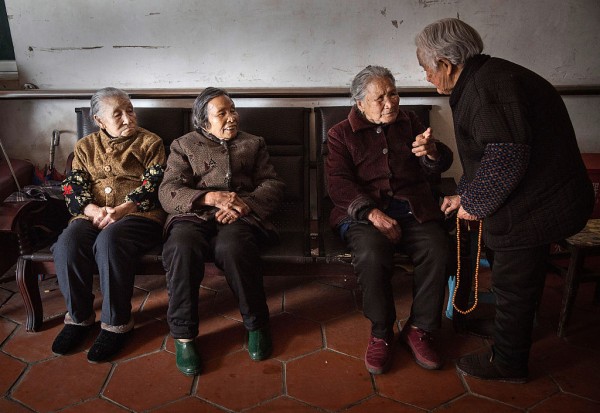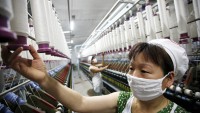China Faces Challenges of Declining Labor Force & Aging Population
| S Satapathy | | Apr 01, 2016 10:33 AM EDT |
(Photo : Getty Images) Elderly Chinese residents chat as they wait before a meal at the Ji Xiang Temple and nursing home on March 18, 2016 in Sha County, Fujian province, China. The Buddhist temple, which houses a nursing home, opened in 2000 as a spiritual promise by a revered elderly monk to provide care and compassion for the aged.
The data from the National Bureau of Statistics (NBS) showed that during the period 2015, China's working age population reached to 911 million and the country had close to 222 million senior citizens.
People aged between 16 and 59 will decrease to 896 million in 2020 and to 824 million in 2030. If this trend continues, the country's working-age population is predicted to shrink from last year's 66.3 percent to 56.9 percent by 2030.
Like Us on Facebook
The United Nations predicted that the rise of people over age 65 will have a negative bearing on China's labour availability.
The cheap labor available in China after its reform and opening-up sparked a sustained economic boom, but as the generation of the country's family planning policies came of age, the once inexhaustible supply of laborers began to dry up.
The working age population first declined in 2012, dropping 0.6 percent year-on-year, and it has shrunk annually since. China ended the decades old one-child policy this year and allowed all couples to have two children as the demographic crisis deepened with sharp rise in the population of old people.
China's current demographic structure is severely distorted as the country now faces serious problems such as low fertility, an ageing society and gender imbalance. This may hinder economic development as well as social stability in the long run, labor experts warned. The country is already facing the labor shortages in many of its cities including in manufacturing powerhouse of Guangdong Province.
Tagschina, working population, demographic challenge, United Nations, population, two-child policy, labour
©2015 Chinatopix All rights reserved. Do not reproduce without permission
EDITOR'S PICKS
-

Did the Trump administration just announce plans for a trade war with ‘hostile’ China and Russia?
-

US Senate passes Taiwan travel bill slammed by China
-

As Yan Sihong’s family grieves, here are other Chinese students who went missing abroad. Some have never been found
-

Beijing blasts Western critics who ‘smear China’ with the term sharp power
-

China Envoy Seeks to Defuse Tensions With U.S. as a Trade War Brews
-

Singapore's Deputy PM Provides Bitcoin Vote of Confidence Amid China's Blanket Bans
-

China warns investors over risks in overseas virtual currency trading
-

Chinese government most trustworthy: survey
-

Kashima Antlers On Course For Back-To-Back Titles
MOST POPULAR
LATEST NEWS
Zhou Yongkang: China's Former Security Chief Sentenced to Life in Prison

China's former Chief of the Ministry of Public Security, Zhou Yongkang, has been given a life sentence after he was found guilty of abusing his office, bribery and deliberately ... Full Article
TRENDING STORY

China Pork Prices Expected to Stabilize As The Supplies Recover

Elephone P9000 Smartphone is now on Sale on Amazon India

There's a Big Chance Cliffhangers Won't Still Be Resolved When Grey's Anatomy Season 13 Returns

Supreme Court Ruled on Samsung vs Apple Dispute for Patent Infringement

Microsoft Surface Pro 5 Rumors and Release Date: What is the Latest?












